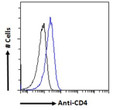| Post Translational Modifications | Palmitoylation and association with LCK contribute to the enrichment of CD4 in lipid rafts. Phosphorylated by PKC.phosphorylation at Ser-433 plays an important role for CD4 internalization. |
| Function | Integral membrane glycoprotein that plays an essential role in the immune response and serves multiple functions in responses against both external and internal offenses. In T-cells, functions primarily as a coreceptor for MHC class II molecule:peptide complex. The antigens presented by class II peptides are derived from extracellular proteins while class I peptides are derived from cytosolic proteins. Interacts simultaneously with the T-cell receptor (TCR) and the MHC class II presented by antigen presenting cells (APCs). In turn, recruits the Src kinase LCK to the vicinity of the TCR-CD3 complex. LCK then initiates different intracellular signaling pathways by phosphorylating various substrates ultimately leading to lymphokine production, motility, adhesion and activation of T-helper cells. In other cells such as macrophages or NK cells, plays a role in differentiation/activation, cytokine expression and cell migration in a TCR/LCK-independent pathway. Participates in the development of T-helper cells in the thymus and triggers the differentiation of monocytes into functional mature macrophages. (Microbial infection) Primary receptor for human immunodeficiency virus-1 (HIV-1). Down-regulated by HIV-1 Vpu. Acts as a receptor for Human Herpes virus 7/HHV-7. |
| Protein Name | T-Cell Surface Glycoprotein Cd4T-Cell Surface Antigen T4/Leu-3Cd Antigen Cd4 |
| Database Links | Reactome: R-HSA-1462054Reactome: R-HSA-167590Reactome: R-HSA-173107Reactome: R-HSA-180534Reactome: R-HSA-202424Reactome: R-HSA-202427Reactome: R-HSA-202430Reactome: R-HSA-202433Reactome: R-HSA-389948Reactome: R-HSA-449836Reactome: R-HSA-8856825Reactome: R-HSA-8856828 |
| Cellular Localisation | Cell MembraneSingle-Pass Type I Membrane ProteinLocalizes To Lipid RaftsRemoved From Plasma Membrane By Hiv-1 Nef Protein That Increases Clathrin-Dependent Endocytosis Of This Antigen To Target It To Lysosomal DegradationCell Surface Expression Is Also Down-Modulated By Hiv-1 Envelope Polyprotein Gp160 That Interacts WithAnd Sequesters Cd4 In The Endoplasmic Reticulum |
| Alternative Antibody Names | Anti-T-Cell Surface Glycoprotein Cd4 antibodyAnti-T-Cell Surface Antigen T4/Leu-3 antibodyAnti-Cd Antigen Cd4 antibodyAnti-CD4 antibody |
Information sourced from Uniprot.org









